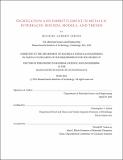Segregation and embrittlement in metallic interfaces : bounds, models, and trends
Author(s)
Gibson, Michael Andrew, Ph. D. Massachusetts Institute of Technology
DownloadFull printable version (13.85Mb)
Other Contributors
Massachusetts Institute of Technology. Department of Materials Science and Engineering.
Advisor
Christopher A. Schuh.
Terms of use
Metadata
Show full item recordAbstract
Metals with grain sizes below 100 nanometers exhibit remarkable hardness [1], wear resistance [2], and superplastic forming behavior [3], in addition to changes in many other properties. These materials are thus of technological interest as structural materials. However, the excess free energy associated with grain boundary formation drives rapid grain growth in pure nanostructured metals at low homologous temperatures [4], preventing traditional (hot) forming and consolidation techniques and restricting practical usage. Such microstructural instability can be suppresed through alloying; thermally stable nanostructured metals can be designed through judicious choice of segregating alloying elements [5, 6, 7]. However, it is not known to what extent these effects are thermodynamic versus kinetic in origin. In order to advance understanding of nanostructure stabilization, in the first part of this thesis, I define general, thermodynamic limits on grain size stabilization via segregation in metals and provide specific thermodynamic models for grain size stabilization of polycrystals via alloying for use in future alloy design. While grain boundary segregation is desirable to inhibit grain growth, such segregation is typically associated with grain boundary embrittlement [8]. In the latter part of this thesis, I demonstrate general principles for the design thermally stable nanocrystalline metals without compromising grain boundary cohesion. More specifically, I create an analytical model of grain boundary embrittlement at equilibrium segregation; construct the largest database on grain boundary and surface segregation energies to date; and utilize this database of segregation energies to quantitatively confirm and deny hypotheses regarding the driving forces for surface segregation, grain boundary segregation, and grain boundary embrittlement. The specific results of this thesis should be useful to metallurgists in understanding and designing grain boundary and surface chemistry, and in designing materials resistant to grain boundary decohesion. The quantitative methods developed in this thesis should be useful to the broader materials community as a whole.
Description
Thesis: Ph. D., Massachusetts Institute of Technology, Department of Materials Science and Engineering, 2016. This electronic version was submitted by the student author. The certified thesis is available in the Institute Archives and Special Collections. Cataloged from student-submitted PDF version of thesis. Includes bibliographical references (pages 211-237).
Date issued
2016Department
Massachusetts Institute of Technology. Department of Materials Science and EngineeringPublisher
Massachusetts Institute of Technology
Keywords
Materials Science and Engineering.